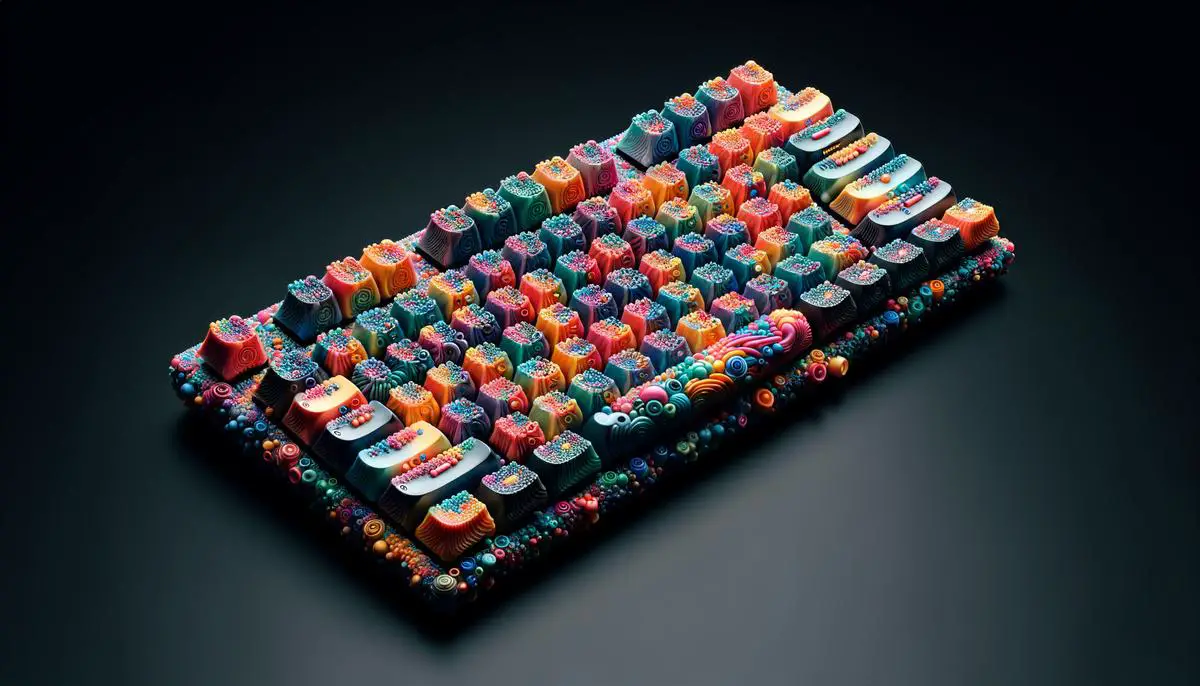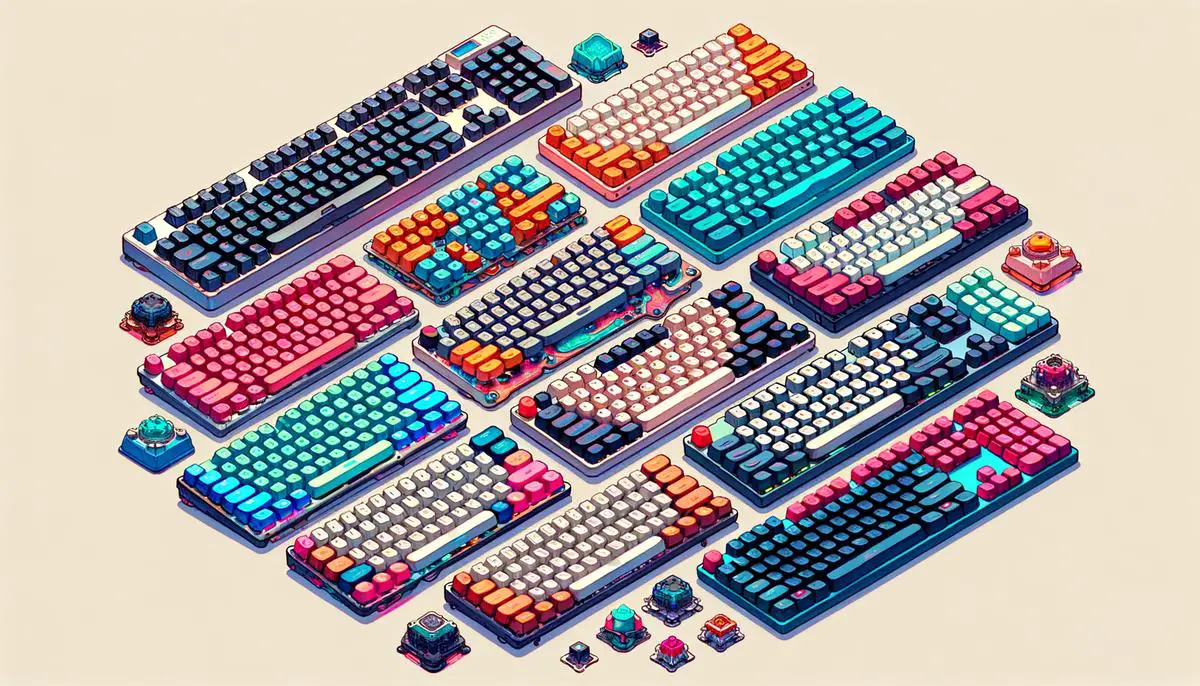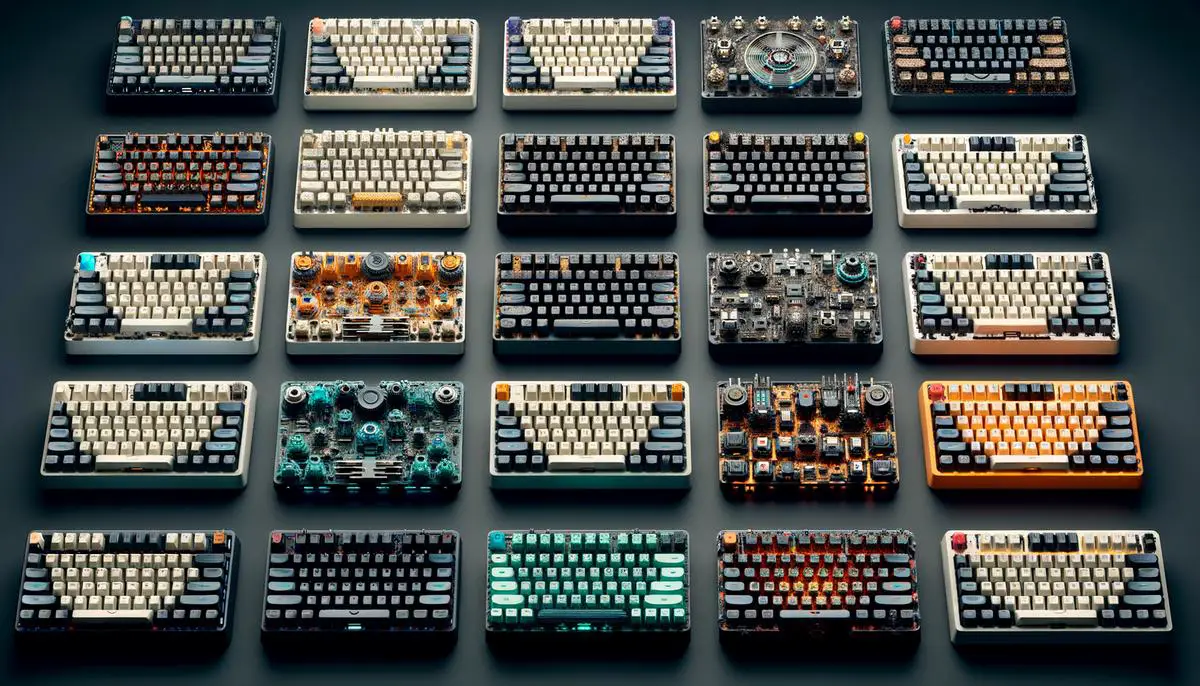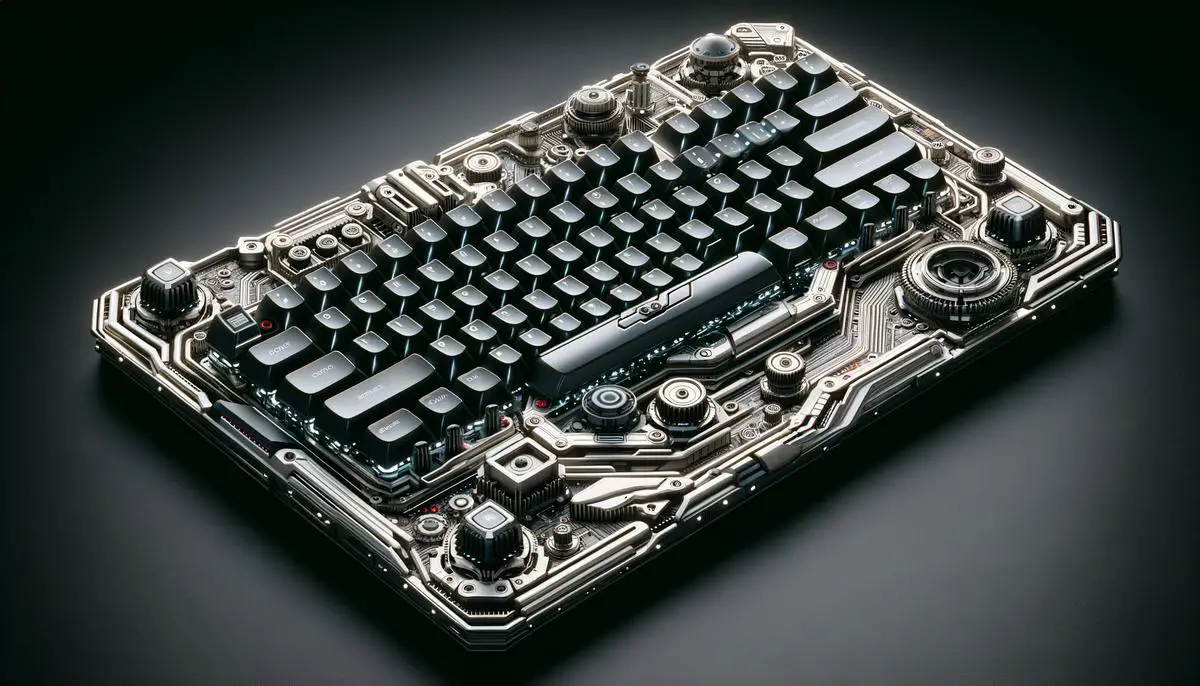Entering the compact universe of 60% mechanical keyboards reveals a landscape where efficiency meets customization. This domain, where every square inch of desk space counts, offers a surprising array of benefits for those willing to adjust to its scaled-down size. The journey through this space is not about sacrificing utility for form but discovering how such a minimalist approach can redefine our interaction with digital environments.
Understanding 60% Mechanical Keyboards
60% mechanical keyboards strip down the traditional keyboard layout to just the essentials. This means saying goodbye to the numeric keypad, function row, and navigation keys. What’s left is a compact, efficient typing tool that fits more lifestyles than you might think.
At first glance, their small size catches the eye. These boards take up significantly less desk space than their full-sized counterparts. This not only frees up real estate on a crowded desk but also contributes to a cleaner, more minimalist workspace. For those who value aesthetics as much as functionality, this feature alone can be a game-changer.
Portability is another key advantage. Because of their reduced dimensions, 60% keyboards are easy to pack up and take on the go. Whether you’re a student bouncing between classes or a professional jetting off for conferences, being able to easily transport your typing tool can make all the difference in staying productive.
The typing experience on a 60% keyboard can feel uniquely satisfying. Without the extra keys, each press is deliberate, reducing the likelihood of errors for touch typists. The mechanical switches beneath each key offer tactile feedback that many users find more pleasant and responsive than the mushy feel of traditional rubber dome keyboards.
Enthusiasts appreciate the high level of customization available with 60% keyboards. From switch types to keycap materials and colors, you can personalize nearly every aspect of your keyboard. This level of customization isn’t just about looks; it allows users to tailor their keyboards for the perfect typing feel, sound, and performance.
Despite their compact form, 60% mechanical keyboards don’t sacrifice functionality. Key combinations, also known as shortcuts or layers, unlock the missing functions. For example, pressing a certain key combination can replicate the functions of the missing arrow keys. This system keeps the keyboard’s footprint small while still providing access to a full range of keyboard functions.
The appeal of 60% mechanical keyboards extends beyond aesthetics and portability to something more intangible: the joy of use. Many users report a more enjoyable typing experience that makes mundane tasks a little more pleasant. Whether it’s the satisfying click of the keys, the personalized setup, or simply the extra desk space, these compact keyboards can turn the act of typing into a little moment of joy.
In summary, 60% mechanical keyboards offer an attractive combination of compact size, portability, enjoyable typing experience, and customization possibilities. They cater to those looking for a space-saving design without compromising on performance or aesthetics. Whether for work, study, or gaming, these keyboards might just be the perfect fit for your digital lifestyle.

Key Features to Consider
When zeroing in on the crux of what makes a 60% mechanical keyboard stand out, build quality snaps into focus first. A durable frame, often crafted from metal or sturdy plastic, ensures your keyboard can withstand the rigors of daily use. Keys shouldn’t wobble or feel flimsy under your fingers; they should present a firm, satisfying response with every press.
Diving deeper, the heart of these keyboards resides in their switches. Choices abound, from the reliability of Cherry MX to the smooth actuation of Gateron and the versatility of Kailh. Each type offers distinct tactile experiences, noise levels, and actuation forces, catering to preferences ranging from feather-light touches to deliberate, heavy keystrokes.
Keycaps contribute significantly to the keyboard’s feel and durability. High-quality materials like PBT or ABS prevent the legends from fading and maintain a clean, sharp aesthetic. Textured surfaces provide grip and reduce slippage during intense typing sessions or gaming marathons.
Programmability defines another frontier of the 60% mechanical keyboard experience. The capability to remap keys and program macros transforms an ordinary typing instrument into a personalized productivity tool. Users can mold their keyboard to match their workflow, optimizing every action for efficiency and comfort.
Connectivity breathes life into the modern work and play spaces’ evolving demands. The choice between wired and wireless connections offers flexibility. A wired connection promises stable performance for uninterrupted gaming and typing, while Bluetooth or wireless connectivity declutters desks and empowers users to switch between devices seamlessly.
Backlighting, though sometimes seen as just a stylish accessory, holds practical value in low-light conditions. RGB models provide a spectrum of colors, enabling users to create custom lighting setups that highlight essential keys or simply match their aesthetic preference.
Each of these elements converges to define the apex of 60% mechanical keyboard design, bridging the gap between aesthetics and functionality. The journey to picking the perfect keyboard becomes less about compromise and more about finding a device that echoes your individual needs and style.

Popular Models on the Market
The Anne Pro 2 steps onto the scene with a whisper of agility and a storm of features. Loved equally by gamers and programmers, this 60% mechanical keyboard is both versatile and powerful. It boasts a 1900mAh battery ensuring long bouts of cordless typing or gaming are uninterrupted by the quest for a power outlet. Offering both Bluetooth 5.0 for wireless connectivity and a Type-C USB for a wired option, users find flexibility in how they set up their work or play environment.
Ducky One 2 Mini is another top contender, dazzling users with its vibrant RGB lighting. Beyond its cosmetic appeal, this keyboard excels in performance with a range of Cherry MX switches to choose from, catering to the precise needs of every typist’s preference, whether they crave the soft bump of an MX Brown or the clicky joy of an MX Blue. It becomes a natural extension of the user’s intentions, translating thoughts into digital actions with seamless ease.
For those leaning towards a minimalist aesthetic without sacrificing functionality, the DIERYA DK63 plants its flag. This model offers an enticing blend of affordability and performance, with features such as waterproof circuitry for the accidental spills that life throws your way. Its compatibility with various devices is a significant draw, showcasing connectivity across Windows, Mac, and even Android platforms through its reliable Bluetooth 5.1 support.
The Happy Hacking Keyboard (HHKB) Professional 2 takes aim at a niche market with its Topre switches that provide a unique typing sensation merging the tactile feedback typists love with near-silent operation. Its layout might challenge newcomers but promises an ergonomic boon to seasoned users, contributing to reduced hand fatigue over long periods. Esteemed within coding communities, the HHKB Professional 2 is a testament to how tailored design can enhance daily professional tasks.
Glorious GMMK Compact focuses on customization unleashing a fully modular mechanical keyboard that allows the swapping and customization of switches without the need for soldering. This feature shines for users who view their keyboards as ever-evolving tools, adapting to new needs or preferences over time. It appeals not only to gamers looking for that perfect actuation but also to creative professionals striving for a keyboard that can keep pace with their dynamic workflow.
Each of these keyboards targets specific aspects of the user desire – be it customization, aesthetic, performance, or ergonomic comfort. Their shared mission, however, lies in elevating the mundane act of typing or gaming into a refined experience bustling with personal flair and precision engineering. Choosing the right one translates to aligning with one’s priorities, whether they tilt towards the silent operation, durability, customization, or sheer aesthetic value.

Customization and Accessories
Changing out keycaps is one of the simplest ways to make your 60% mechanical keyboard reflect your personal taste and vibe. With an abundance of keycap sets available, constructed from materials ranging from ABS to PBT, you can select from various colors, designs, and textures. Marvel, anime, or wholly custom designs—options are virtually limitless, allowing you to give your keyboard a total makeover that speaks to who you are.
Switch modifications unlock another level of customization by changing the very feel and sound of your typing. Whether you prefer the quietness of linear switches or the tactile feedback from a clicky switch, swapping them out can transform the typing experience to suit your preferences better. This alteration does require a bit of technical know-how but is well within reach for those willing to learn or seek help from the community.
Adding o-rings to your keyboard’s switches can reduce noise—a bonus for shared spaces or recording environments. Placed under each keycap, these tiny rings dampen the sound of the key being pressed, lessening the impact noise. It’s a smart, minimal-effort mod for users after a quieter, more muted typing sound.
The frame of your 60% keyboard provides more than structure; it contributes to both the aesthetic and typing resonance. Aftermarket frames, constructed from woods or metals, can markedly elevate your keyboard’s look and feel. While a wooden frame brings warmth and natural character, a metal frame could add a sleek, modern appeal and change the acoustic profile of your keyboard.
Exploring carrying cases not only protects your keyboard during transport but also offers a touch of personal flair. Cases come in various styles and materials—one to match every taste, ensuring your keyboard is not just secure but also an extension of your style.
Custom USB cables offer yet another layer of personalization. Available in a wide array of colors and patterns, with different connector options (USB-C, microUSB), these cables can be the finishing touch that ties the whole aesthetic together. The freedom to choose features like aviator connectors further emphasizes your keyboard setup’s uniqueness.
All these enhancements go beyond mere visual appeal; they allow for a deeper connection between the user and their device. The process of choosing each component, whether for performance, comfort, or style, fosters not just a tool for typing but an extension of one’s self-expression. The quest for the perfect typing experience and aesthetic leads many down a rabbithole of customization, where each choice further refines the joy of use and pride of ownership inherent in the 60% mechanical keyboard community.

The Future of 60% Mechanical Keyboards
Advances in wireless technology will transform 60% mechanical keyboards.
Future models might boast longer battery lives and more stable connections, crucial for both gamers and professionals. Bluetooth 5.2 or even upcoming iterations could enable seamless multi-device syncing, allowing users to switch effortlessly between a PC, tablet, and smartphone.
Sustainability will become a significant focus. Keyboards could feature recyclable materials or biodegradable plastics, reducing environmental impact. Innovations might extend to packaging, using eco-friendly materials and minimalistic designs to further decrease waste.
Switch technology will evolve. Users might see switches with adjustable actuation points, allowing customization of the typing experience without changing components. Noise-reduction technologies could also improve, making mechanical keyboards more appealing in shared workspaces.
The community’s influence will lead to more user-centric designs. Feedback from keyboard enthusiasts could drive companies to introduce modular designs, enabling users to replace switches or keys easily. This feedback loop might also encourage the development of open-source software for keyboard customizations, enhancing programmability and setting new standards in personalization.
Ergonomics will advance. We could witness the introduction of 60% keyboards with adjustable angles or detachable wrist rests, designed to reduce strain during prolonged use. Materials that provide better grip or comfort during typing sessions might also come into play.
Connectivity options will expand. Beyond Bluetooth, future keyboards may incorporate Wi-Fi for cloud-syncing custom settings, making it easier to maintain consistent workflows across different devices or locations. NFC technology might enable quick pairing processes or even secure authentication processes for device access.
As AI technologies mature, keyboards could offer predictive typing adjustments or automatically switch profiles based on the application in use. Imagine a keyboard that adjusts its responsiveness and feedback depending on whether you’re coding, gaming, or writing an email.
The symbiotic relationship between keyboard manufacturers and the enthusiast community will flourish. Collaboration on limited-edition models or community-driven design competitions could become more common, directly influencing mainstream models and customization features.
In the realm of keycaps and switches, material science will play a pivotal role. Innovations may introduce self-healing materials for keycaps to reduce wear over time or switches that can adjust their resistance electronically based on user preference, offering a new dimension of customization.
Ultimately, the future of 60% mechanical keyboards is bright, promising innovations that enhance connectivity, sustainability, and user experience. As technology advances, these compact powerhouses will become even more integral to our digital interactions, reflecting our personalities and adapting to our ergonomic needs even more seamlessly.

In conclusion, the essence of the 60% mechanical keyboard lies not just in its compact footprint or the potential for personalization, but in its ability to transform the mundane task of typing into a pleasurable experience. This transformation is perhaps the most compelling reason to consider making the switch. It’s about finding joy in the keystrokes, turning every interaction with your digital world into an opportunity for satisfaction.
- Guide to Life Is Strange: True Colors Ch. 1 Choices - April 4, 2024
- Catching Spiritomb in Pokemon BDSP - April 4, 2024
- Mastering Life Is Strange: Key Choices in Chapter 1 - April 4, 2024
Views: 1








